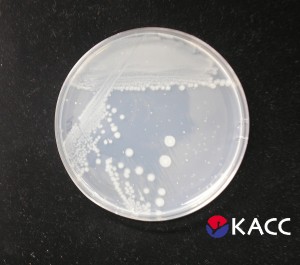Contact: Lynn Yarris (510) 486-5375; [email protected]
In the drive to derive clean, green and renewable liquid transportation fuels from cellulosic biomass, a critical factor will be finding or developing microbes that not only are able to ferment complex sugars, but are also able to withstand the high temperatures and other grueling conditions of fuel production, and do not become inhibited by the fuel that is being produced. One potential candidate has already emerged and researchers with the U.S. Department of Energy (DOE) Joint BioEnergy Institute (JBEI) have made vital determinations about its metabolism via an unusual experimental route that promises to greatly speed up future research efforts in this field.

Jay Keasling (left) and Rajat Sapra at the Joint BioEnergy Institute have developed a unique metabolic analysis technique based on the carbon-13 isotope that can greatly speed up the search for new biofuel microbes. (Photo by Roy Kaltschmidt, Berkeley Lab Public Affairs)
“Our results show that the recently discovered extremophile – the bacterium Geobacillus thermoglucosidasius – which thrives in the high temperatures and pressures of petroleum reservoirs, can ferment the major C5 and C6 sugars (e.g., xylose and glucose) in cellulosic biomass and can tolerate high concentrations of ethanol,” said Jay Keasling, CEO of JBEI and a world authority on synthetic biology who led this study. “These capabilities make Geobacillus thermoglucosidasius an ideal microbe for improved production of bio-ethanol and other more advanced biofuels.”
Working with Keasling on this study were Rajat Sapra, a biochemist with Sandia National Laboratories who directs the enzyme optimization program at JBEI, and Yinjie Tang, a chemical engineer now with Washington University in St. Louis. Their results were reported in a paper in the journal Biotechnology and Bioengineering entitled: Analysis of Metabolic Pathways and Fluxes in a Newly Discovered Thermophilic and Ethanol-Tolerant Geobacillus Strain. The paper is available on-line.
Solar energy stored in plant biomass is embedded within the complex sugars of lignocellulose, a matrix of sugars and lignin (the substance that gives strength and structure to plant cell walls). As lignocellulose is the most abundant organic material on Earth, this stored energy represents a potential bonanza for biofuel production provided effective fermentation microbes can be found. Yeast, the most commonly used fermentation microbe, is unable to naturally ferment many of sugars in lignocellulose. Preliminary studies suggested Geobacillus thermoglucosidasiusm as a candidate but measuring its full potential for biofuels production required detailed information on its metabolism.

A JBEI study suggests that Geobacillus thermoglucosidasius, a recently discovered extremophile, could be an ideal microbe for improved production of biofuels. (image courtesy of the Korean Agricultural Culture Collection)
Scientists normally obtain metabolic information on a microbe through the sequencing of its genome and subsequent genomic, proteomic and physiological studies – a process that can take months or even years to complete. The JBEI researchers developed a new strategy that dramatically shrank this time frame. Through a combination of in vitro enzyme assays and a unique metabolic flux analysis they developed based on the carbon-13 isotope, they were able to complete their metabolic studies in less than two weeks.
Metabolic flux is a measurement of the enzymes and reaction activities taking place along a given metabolic pathway as an organism converts its food (like sugars) into energy and end-products (like ethanol). The researchers used glucose labeled with Carbon-13, a rare but stable isotope of carbon, to study the distribution of C-13 in the metabolites formed from glucose. The position of the C-13 label and the metabolites formed serve as a measurement of metabolic flux in real-time and help determine the metabolic pathways of the organism.
“Using our methodology, one can rapidly analyze whether a bacterium is suitable as a biofuels host at an extremely fast time frame as compared to the traditional methods,” said Sapra. “This is especially important now that we are discovering new and novel bacteria at a pace much, much faster than can be analyzed using the classical techniques. Our isotopomer-based approach for studying cellular metabolisms will not only enable us to identify the best and most promising hosts, but will also provides guidelines for engineering new metabolic pathways that promote biofuel production as well as other environmental and industrial applications.”
JBEI is one of three U.S. Department of Energy Bioenergy Research Centers. Its scientific partnership is led by Lawrence Berkeley National Laboratory (Berkeley Lab) and includes the Sandia National Laboratories (Sandia), the University of California (UC) campuses of Berkeley and Davis, the Carnegie Institution for Science and the Lawrence Livermore National Laboratory (LLNL). Headquartered in EmeryStation East, a state-of-the-art laboratory building in Emeryville, JBEI’s five-year mission is to advance the development of the next generation of biofuels through the efficient conversion into fuels of cellulosic biomass.
Additional Information
For more information about the Joint BioEnergy Institute visit the website at www.jbei.org